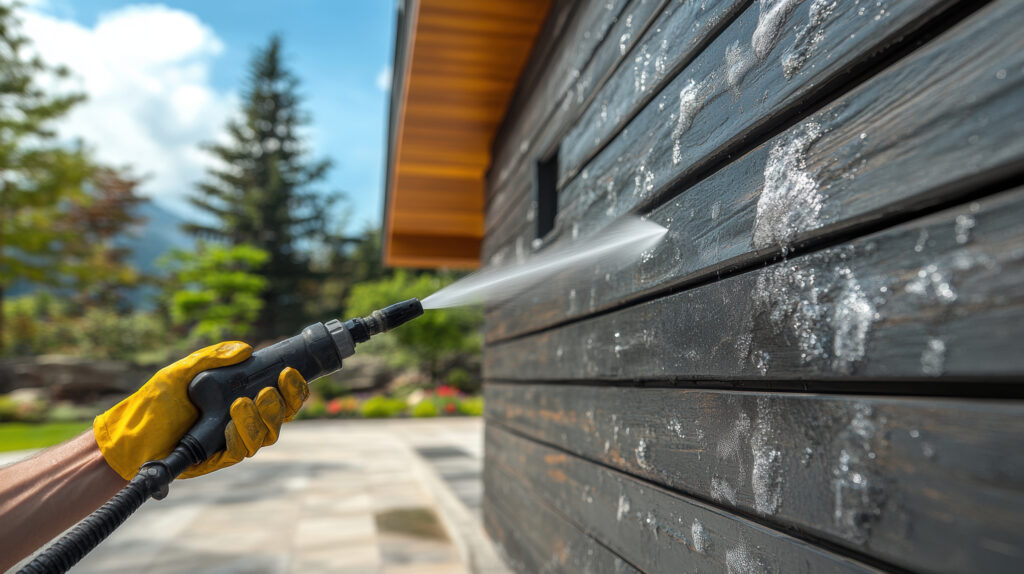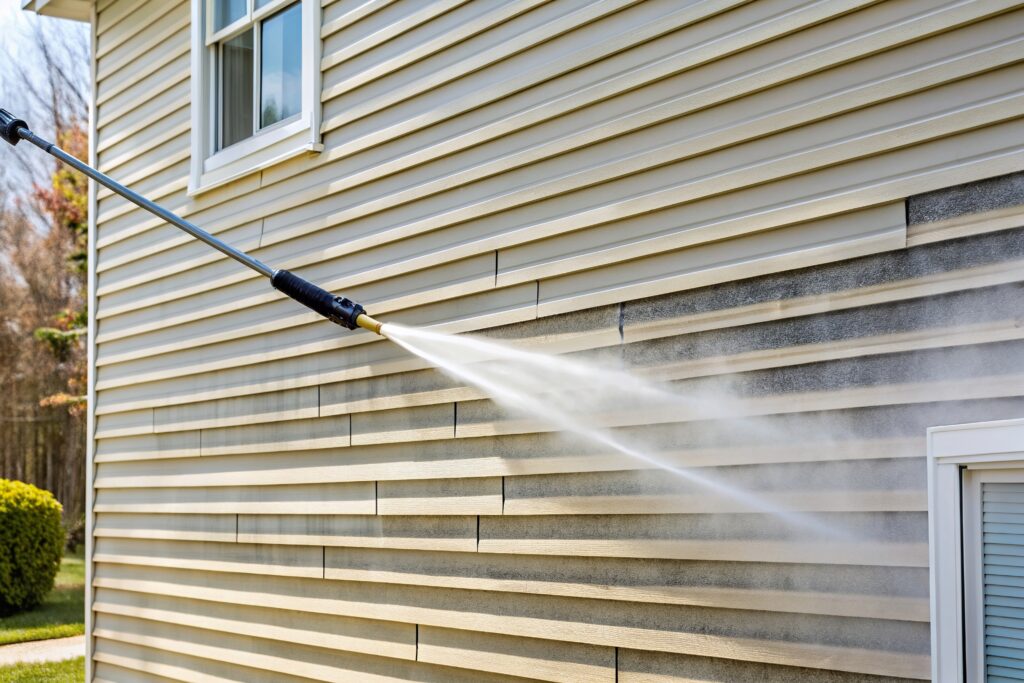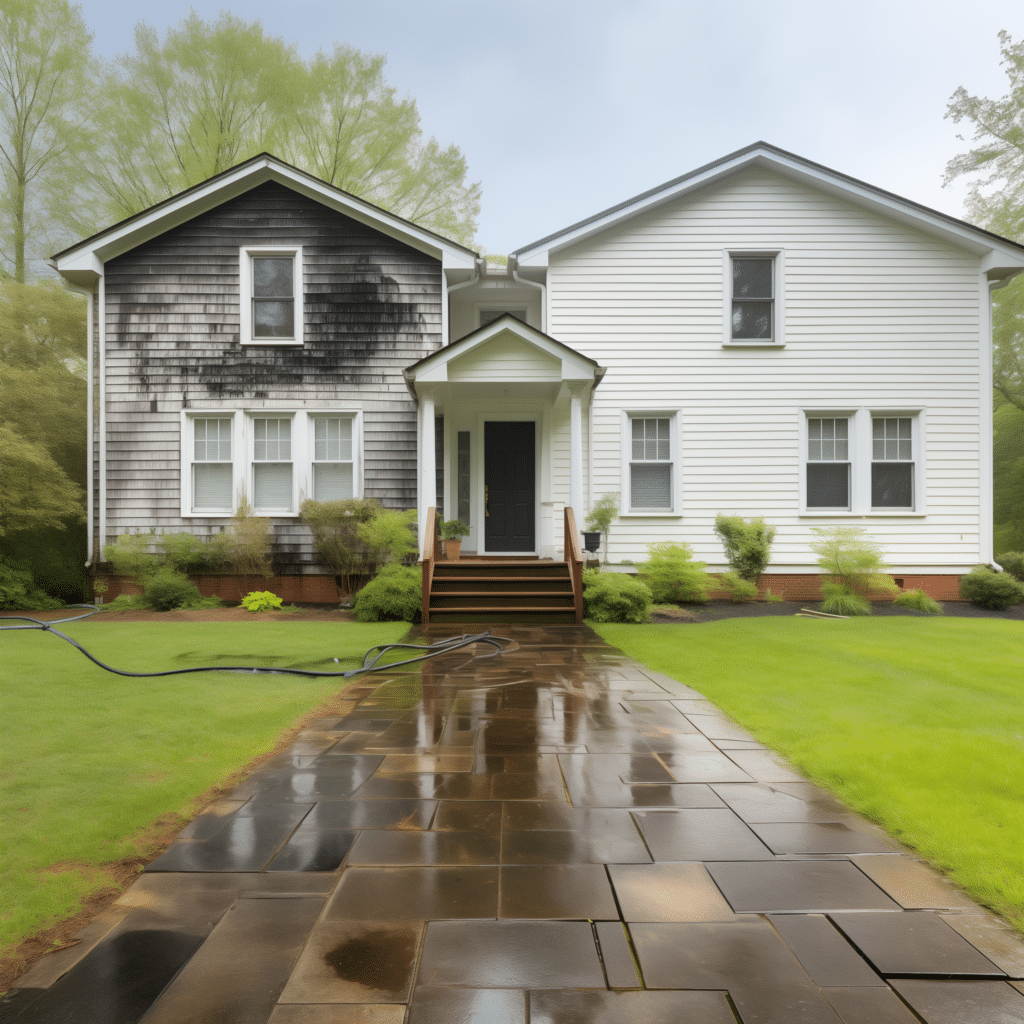
If you’re a homeowner, you probably know how quickly siding can lose its fresh, clean look. Dirt, pollen, mold, and mildew seem to sneak up on your house and suddenly the once-bright exterior looks a little dull. Pressure washing is one of the best ways to bring your siding back to life—but here’s the catch: not all siding should be cleaned the same way.
Vinyl, wood, and brick siding all have their own quirks. What works perfectly for one could cause damage to another. So before you pull out the pressure washer (or hire someone to do it for you), it’s worth knowing the differences. Let’s go over what makes each siding type unique and how to keep it looking great.
Cleaning Vinyl Siding with a Pressure Washer
Vinyl siding is popular for a reason—it’s affordable, durable, and pretty low-maintenance. The good news is, it’s also one of the easiest siding materials to pressure wash.
Here’s what to know:
- Use moderate pressure (usually 1,300–1,600 PSI). Too much force can crack or loosen panels.
- Always spray downward, not upward, so water doesn’t get trapped behind the siding.
- A mild cleaning solution works wonders for removing green algae or black streaks.
Why homeowners love pressure washing vinyl:
- It brightens up faded siding quickly.
- Mold and mildew can be washed away in minutes.
- You can clean large areas fairly fast.
What to watch out for:
- Spraying too hard may leave cracks that aren’t always easy to spot right away.
- If water sneaks behind the siding, it can lead to mold or rot inside the walls.
- Harsh cleaners may cause streaks or fading.
Bottom line: Vinyl is usually the most straightforward siding to wash, but it still requires the right technique to avoid problems.
Cleaning Wood Siding with a Pressure Washer
Wood siding has a timeless, natural beauty—but it’s also the most delicate when it comes to pressure washing. Because wood is porous, it soaks up water easily, and too much pressure can do serious damage.
Here’s what to know:
- Stick with low pressure (about 500–800 PSI). Think of it as a gentle rinse, not a blast.
- Follow the grain of the wood while spraying.
- Use a wood-safe cleaner (oxygen bleach is a good option) instead of harsh chemicals.
Why homeowners choose to pressure wash wood siding:
- It brings back the wood’s natural color.
- Washing helps prep the surface before sealing, staining, or painting.
- Mold and mildew are kept in check.
What to watch out for:

- High pressure can cause splintering or permanent gouges.
- If wood absorbs too much water, it may warp or rot.
- Washing too often can strip protective finishes.
Bottom line: Wood siding can look amazing after a gentle wash, but it’s definitely a job that benefits from an experienced touch.
Cleaning Brick Siding with a Pressure Washer
Brick is strong and long-lasting, but that doesn’t mean you can just blast away with high pressure. The tricky part with brick isn’t the bricks themselves—it’s the mortar that holds them together. Mortar is much softer and can crumble if the pressure is too strong.
Here’s what to know:
- Brick can usually handle higher pressure (around 1,500–2,500 PSI), but be cautious around mortar joints.
- Spray at an angle instead of directly into the mortar lines.
- Stick with masonry-safe cleaners (avoid acidic products that can eat away at the brick).
Why homeowners benefit from pressure washing brick:
- It removes years of grime, moss, and stains.
- Keeps mold, mildew, and algae from taking over.
- Restores that classic, clean-brick look.
What to watch out for:
- Too much pressure can damage mortar, leading to costly repairs.
- Trapped water in brick pores may cause flaking (called “spalling”) in colder weather.
- Using the wrong cleaner can leave stains behind.
Bottom line: Brick is tough, but the mortar isn’t—so the right pressure and cleaning solutions are key.
A Quick Comparison
Here’s a quick snapshot of the differences in pressure washing vinyl, wood, and brick siding:
| Siding Type | Best PSI Range | Cleaning Tips | Main Risk |
| Vinyl | 1,300–1,600 | Spray downward, use mild detergent | Cracks, water behind panels |
| Wood | 500–800 | Gentle wash, follow grain, wood-safe cleaner | Splintering, warping, rot |
| Brick | 1,500–2,500 | Avoid blasting mortar, use masonry cleaner | Mortar erosion, trapped moisture |
Should You DIY or Hire a Professional?
Many homeowners wonder if they should rent a pressure washer and tackle siding themselves. For small vinyl siding jobs, it might be doable if you’re careful. But when it comes to wood and brick, things can get risky fast.
Hiring a professional often saves time, stress, and money in the long run. They know how to:
- Adjust pressure levels for each siding type.
- Pick the right cleaning solutions that won’t cause damage.
- Spot early signs of siding issues before they become expensive problems.
- Handle ladders and second-story areas safely.

Final Thoughts
Pressure washing is one of the easiest ways to boost your home’s curb appeal and keep siding in good shape. But remember—vinyl, wood, and brick all have different needs. Vinyl can handle moderate pressure, wood needs a very gentle touch, and brick requires precision to avoid damaging mortar.
If you’re unsure about the right approach, calling in a professional can give you peace of mind (and a sparkling clean home). With the right care, your siding will not only look beautiful but also last for many years to come.
